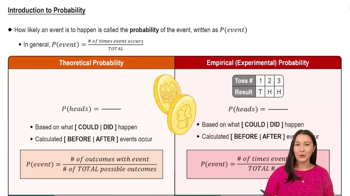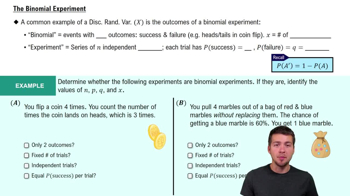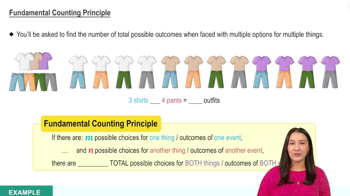Graphical Analysis In Exercises 7 and 8, determine whether the events shown in the Venn diagram are mutually exclusive. Explain your reasoning.
Table of contents
- 1. Intro to Stats and Collecting Data1h 14m
- 2. Describing Data with Tables and Graphs1h 55m
- 3. Describing Data Numerically2h 5m
- 4. Probability2h 16m
- 5. Binomial Distribution & Discrete Random Variables3h 6m
- 6. Normal Distribution and Continuous Random Variables2h 11m
- 7. Sampling Distributions & Confidence Intervals: Mean3h 23m
- Sampling Distribution of the Sample Mean and Central Limit Theorem19m
- Distribution of Sample Mean - Excel23m
- Introduction to Confidence Intervals15m
- Confidence Intervals for Population Mean1h 18m
- Determining the Minimum Sample Size Required12m
- Finding Probabilities and T Critical Values - Excel28m
- Confidence Intervals for Population Means - Excel25m
- 8. Sampling Distributions & Confidence Intervals: Proportion1h 12m
- 9. Hypothesis Testing for One Sample3h 29m
- 10. Hypothesis Testing for Two Samples4h 50m
- Two Proportions1h 13m
- Two Proportions Hypothesis Test - Excel28m
- Two Means - Unknown, Unequal Variance1h 3m
- Two Means - Unknown Variances Hypothesis Test - Excel12m
- Two Means - Unknown, Equal Variance15m
- Two Means - Unknown, Equal Variances Hypothesis Test - Excel9m
- Two Means - Known Variance12m
- Two Means - Sigma Known Hypothesis Test - Excel21m
- Two Means - Matched Pairs (Dependent Samples)42m
- Matched Pairs Hypothesis Test - Excel12m
- 11. Correlation1h 6m
- 12. Regression1h 50m
- 13. Chi-Square Tests & Goodness of Fit1h 57m
- 14. ANOVA1h 57m
4. Probability
Addition Rule
Problem 3.3.17c
Textbook Question
17. Selecting a Card A card is selected at random from a standard deck of 52 playing cards. Find the probability of each event.
c. Randomly selecting a 9 or a face card
 Verified step by step guidance
Verified step by step guidance1
Step 1: Understand the problem. A standard deck of 52 playing cards consists of 4 suits (hearts, diamonds, clubs, spades), each containing 13 cards. The goal is to calculate the probability of randomly selecting either a 9 or a face card (Jack, Queen, King).
Step 2: Determine the total number of favorable outcomes. There are 4 nines in the deck (one for each suit) and 12 face cards (Jack, Queen, King, each appearing in all 4 suits). Add these together to find the total number of favorable outcomes: 4 (nines) + 12 (face cards) = 16.
Step 3: Recall the formula for probability. The probability of an event is given by the formula: . In this case, the total number of outcomes is the total number of cards in the deck, which is 52.
Step 4: Substitute the values into the formula. Use the favorable outcomes (16) and total outcomes (52) to calculate the probability: .
Step 5: Simplify the fraction if necessary. To express the probability in its simplest form, divide the numerator and denominator by their greatest common divisor (GCD). This step ensures the fraction is reduced to its lowest terms.
 Verified video answer for a similar problem:
Verified video answer for a similar problem:This video solution was recommended by our tutors as helpful for the problem above
Video duration:
2mPlay a video:
Was this helpful?
Key Concepts
Here are the essential concepts you must grasp in order to answer the question correctly.
Probability
Probability is a measure of the likelihood that a particular event will occur, expressed as a number between 0 and 1. In the context of selecting a card from a deck, it quantifies how many favorable outcomes exist compared to the total number of possible outcomes. For example, if there are 4 nines and 12 face cards in a deck, the probability of selecting either is calculated by dividing the number of favorable outcomes by the total number of cards.
Recommended video:

Introduction to Probability
Favorable Outcomes
Favorable outcomes refer to the specific results that satisfy the conditions of the event being analyzed. In this case, the favorable outcomes for selecting a 9 or a face card include the 4 nines and the 12 face cards (Jack, Queen, King). Understanding how to identify and count these outcomes is crucial for calculating the overall probability of the event.
Recommended video:
Guided course

The Binomial Experiment
Total Outcomes
Total outcomes represent the complete set of possible results in a probability scenario. For a standard deck of 52 playing cards, the total outcomes are simply the total number of cards in the deck. This concept is essential for determining the probability, as it serves as the denominator in the probability formula, allowing for the comparison of favorable outcomes to the overall possibilities.
Recommended video:

Fundamental Counting Principle

 5:14m
5:14mWatch next
Master Probability of Mutually Exclusive Events with a bite sized video explanation from Patrick
Start learningRelated Videos
Related Practice
Textbook Question
